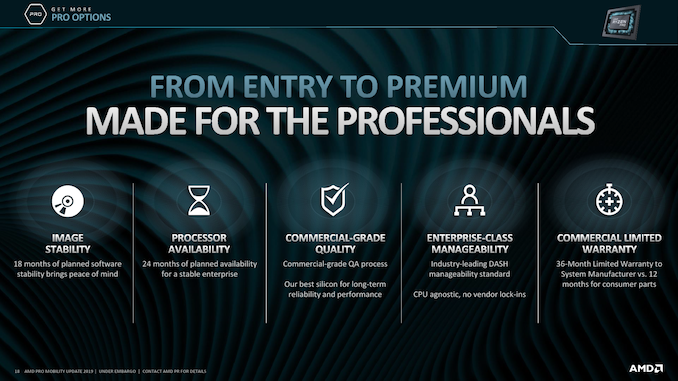AMD Launches 2nd Gen Ryzen Pro & Athlon Pro APUs
by Anton Shilov on April 9, 2019 9:15 AM EST
AMD on Monday introduced four new processors aimed at commercial laptops. The new AMD Ryzen Pro 3000-series as well as AMD Athlon Pro 300-series processors pack up to four x86 cores as well as AMD’s Radeon Vega integrated graphics. Because of improved power efficiency, AMD says that laptops powered by its latest Ryzen Pro APUs will work for up to 12 hours when used for general office workloads.
AMD’s new Pro-series processors are essentially the Ryzen Mobile 3000-series APUs and made using GlobalFoundries’ 12LP process technology. The parts have numerous features supported by AMD’s Pro-series products, such as a built-in TrustZone security processor, DASH manageability, Secure Boot, Content Protection, per-Application security, fTPM 2.0, Transparent Secure Memory Encryption (TSME), and some other technologies are they key feature which differentiate AMD’s Pro from the company’s regular processors for client PCs.
Furthermore, AMD uses wafers with highest yields/least amount of defective parts to build the Ryzen Pro in a bid to meet long term reliability. These CPUs are covered by a 36-month limited warranty, up from 12-month warranty for consumer processors. AMD also guarantees that its Pro-series products will be available for at least 24 months after initial launch and also provides 18 months of planned software stability.
The family of AMD’s 2nd generation Ryzen Pro Mobile processors includes four models: the Ryzen 7 Pro 3700U, the Ryzen 5 Pro 3500U, the Ryzen 3 Pro 3300U, and the Athlon Pro 300U. The Ryzen Pro-branded parts feature four cores with or without SMT, whereas the Athlon Pro device has two cores. All of the APUs have an integrated Radeon Vega GPU, yet with a different configuration. The new APUs feature a TDP of up to 15 W and are therefore aimed at ultra-portable laptops.
| AMD's 2nd Gen Ryzen Pro Specifications | |||||||
| Cores Threads |
Frequency | Cache L2 + L3 |
GPU | TDP | |||
| Base | Boost | ||||||
| Ryzen 7 Pro 3700U | 4/8 | 2.3 GHz | 4.0 GHz | 6 MB | Vega 10 | 15 W | |
| Ryzen 5 Pro 3500U | 2.1 GHz | 3.7 GHz | Vega 8 | ||||
| Ryzen 3 Pro 3300U | 4/4 | 2.1 GHz | 3.5 GHz | Vega 6 | |||
| Athlon Pro 300U | 2/4 | 2.4 GHz | 3.3 GHz | 5 MB | Vega 3 | ||
When compared to AMD’s 1st generation Ryzen Pro Mobile parts, the Ryzen 7 Pro 3700U and the Ryzen 5 Pro 3500U offer slightly higher base as well as turbo clocks. By contrast, the Ryzen 3 Pro 3300U features a lower base frequency, yet a slightly higher turbo frequency, when compared to the Ryzen 3 Pro 2300U.
(For those interested, it should be noted that the Athlon Pro 300U is a full 12nm chip, built on the Zen+ Picasso design, whereas the non-Pro version is a 14nm chip, and a second iteration of Raven Ridge.)
AMD’s own tests show that its Ryzen 7 Pro 3700U is ~1% better than the 8650U in PCMark and up to double in performance when graphics comes into the mix.
Obviously, GPU-intensive workloads are the ones where AMD’s APUs outshine Intel’s CPUs. Meanwhile, general-purpose performane of AMD's and Intel's processors for commercial laptops is very close, according to AMD.
AMD has already started to ship its Ryzen Pro 3000-series and Athlon Pro 300-series processors to its partners among PC makers. HP and Lenovo are expected to be the first to offer commercial laptops based on the new APUs. Other manufacturers are projected to follow later in 2019.
Related Reading
- HP Unveils ProDesk 405 G4 Desktop Mini PC: An SFF Ryzen Pro Desktop
- Two New 35W Raven Ridge Parts: AMD Athlon 200GE and Athlon Pro 200GE
- AMD Launches Ryzen Pro with Vega: Mobile APUs and Desktop APUs
- AMD Launches Ryzen PRO CPUs: Enhanced Security, Longer Warranty, Better Quality
Source: AMD




















40 Comments
View All Comments
TristanSDX - Tuesday, April 9, 2019 - link
nothing is better than solid rebrandValantar - Tuesday, April 9, 2019 - link
No rebrand here. It's a new design with a new architecture revision (full Zen+, unlike the "halfway to Zen+ that RR was) built on a slightly improved process node (12nm is nothing more than a refined 14nm, but it _is_ refined, after all). Is this a real generational update? Arguably not, but these are bound to carry a lot of refinements and bug fixes from the 1st-gen chips.wumpus - Tuesday, April 9, 2019 - link
The statement "Furthermore, AMD uses wafers with highest yields/least amount of defective parts to build the Ryzen Pro in a bid to meet long term reliability." can not be true unless Ryzen Pro is nothing more than a rebrand of existing 2200G-2400G-2600G chips, unless all the discards are going to "athlons". They aren't going to sell enough athlon pros to justify such a wafer binning.SaberKOG91 - Tuesday, April 9, 2019 - link
The mobile Pro parts are a specific binning of the mobile part, not the desktop parts. These have to run at vastly different TDPs so it really makes no sense to not have a specific die for it.I have a Radeon Pro 2700U and I can tell you that it also has a non-pro counterpart with the same paper specs. The main difference is that the Pro gets certified by ISVs which is important for commercial software users (hint: some licenses expressly forbid running on non-certified hw). There also seems to be some indication that Pro parts can support ECC memory better than non-pro, at least for mobile. They don't need to do special wafer binning to turn things on and off like that, but they may choose to bin only the dies with the fewest defects as Pro models, and then shuffle overflow into the normal non-pro bins.
Dragonstongue - Friday, April 12, 2019 - link
Also the PRO parts for Ryzen that I have seen compared to standard (example) Ryzen 2700 vs Ryzen 2700 PRO...same exact specs, but, the PRO out does the non pro for some reason in most things, not massive margin, but better none the less, interesting because prior to such, near 100% cases, desktop enjoyed the "quickest" speed wise and spec wise often enough were faster than PRO, Nv changed a touch with Ti stuff and Titan, AMD with Vega and prior to that Fury line and such.It should :kind of; be that way, because the PRO parts likely have been "voltage tuned" right off the bat, so is like taking Vega 56, drop core volts done right you automatically gain speed and reduce power consumption (by large amount if you get a golden chip)
maybe AMD "noticed such" with Ryzen, and said "cool" so they voltage tune, which would make absolute sense if nothing else, it would have to be "at the factory" only thing I can see being the reason, normally PRO does not run games as well (as an example) cause they turn down clocks to keep power in check by default spec, Ryzen PRO, not so much.....voltage tuned ? for sure bin tested and moved around absolutely, but they seem to be pretty much same price sometimes less then the desktop equivalent model, but run faster and cooler .... freebee for the PRO crowd instead of other way round? (which also makes sense, gamers while in the tens or hundreds of millions are but a drop in the bucket of the computing world, significant, but just a portion none the less.
server, workstation, designers, bank institute etc is what currently forms the "world" mobile is it's own closed in beast of course
Valantar - Tuesday, April 9, 2019 - link
Uhm, there are non-pro 3000-series mobile APUs, you know...ajp_anton - Wednesday, April 10, 2019 - link
Eh, what?These 3000U Pro parts use the same silicon as the 3000U non-pro parts. That's where the "discards" are going.
drexnx - Tuesday, April 9, 2019 - link
even RR was a big improvement over SR in terms of platform features actually working.I never see my SR 1700 turbo correctly and my RR 2200G behaves as it should
deil - Tuesday, April 9, 2019 - link
they mentioned that in RR changelog, turbo-magic.about rebrand -> 2400G have 4MB cache and this have 6.
Stuff changed, so its not just a rebrand.
deil - Tuesday, April 9, 2019 - link
I take that back, it was 2+4, i did not notice.still 65W into laptop with 15W without boost clock change? I don't think so. Would go full throttle in first 10 sec....